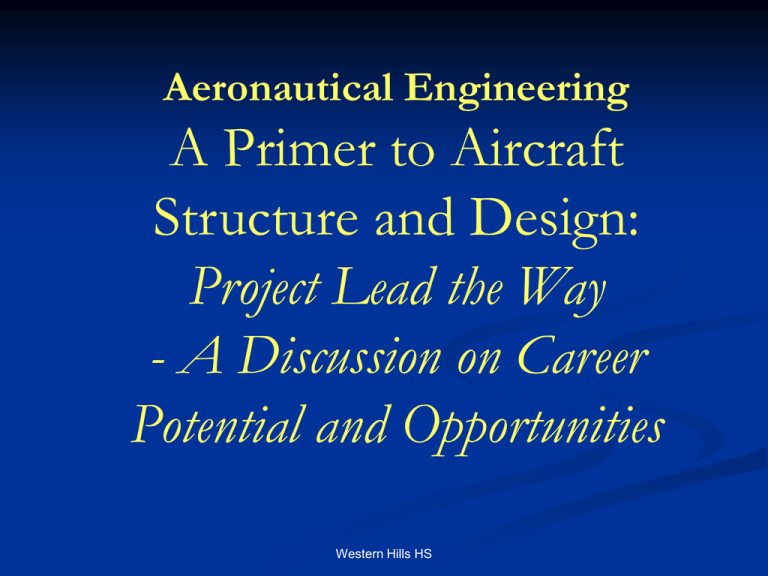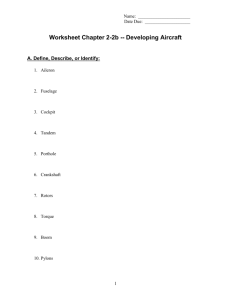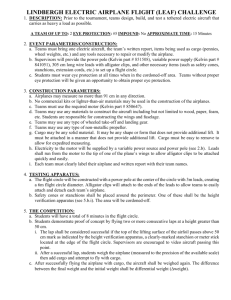PLTW AE Presentation
advertisement

Aeronautical Engineering A Primer to Aircraft Structure and Design: Project Lead the Way - A Discussion on Career Potential and Opportunities Western Hills HS Basic Aircraft Structure Design (What Are the Five Major Parts of an Airplane?) “Fixed Wing” aircraft are generally of similar design: The Five Major components include the power plant (engine / propeller or jet propulsion), wing, tail (empennage), body (fuselage), & landing gear (fixed or retractable) The body or Fuselage section includes the cabin (or cockpit) where pilot (aircrew) and passengers sit; where cargo is carried and may include fuel tanks; this is also the key structure for the attachment of the other four major aircraft components - Early fuselages were made of dope-covered cloth attached to wood runners over bulkheads forming frames which in time was followed by aluminum framing or tubing welded in triangular shapes called trusses. Aircraft development has evolved to a common design known today as the monocoque (or semi-monocoque) fuselage construction pictured below (monocoque is a French word for shell). - - The goal is to achieve light weight with great strength for stresses caused in flight which is to be sustained throughout the operational life-time of the airframe Note that many terms we use for aircraft parts come from French language - France taught us to fly combat in World War One (1917 is when we entered WWI as an Ally to the British and France) Be it a 50 year-plus old B-52 or a 25 year-old F-16 in (in formation with a vintage 70 year old P-47 of WWII) or a 20 year-old C-130H - we build our aircraft to last! If they last long enough, however, military aircraft end up here…but not usually because of a design deficiency-------------------------------------------------------------- (Davis-Montham AFB, Tucson, AZ Aircraft “Boneyard”) Learning Check Question CPS Question 1 Chapter 1, Lesson 3 Aircraft are fragile and not meant to last very long. 1. True 2. False The first major component off the fuselage is the wing which is structurally designed with spars, ribs and stringers - Wings usually contain fuel tanks • One of the three major flight controls is found on the trailing edge toward the outer half of the wing • Aileron • Create aerodynamic forces by the pilot’s left/right movement of a control stick or yoke which cause the aircraft to roll around it’s longitudinal axis • One of the two secondary flight controls is found on the inner portion of the trailing edge of the wing •Flap • Often referred to as a high-lift device, the flaps create additional lift for the wing at lower speeds encountered during take-off and landings which provide greater stability to the airplane at slower speeds • An adverse effect of creating greater lift is increased drag • Advanced High Performance Aircraft (i.e., jet fighters like the F-35)--------- have a combination of the flap and aileron in one aerodynamic control • Flaperon The next major component of the airplane is the Empennage or “tail” section There are two major surfaces on the Empennage critical to an airplane’s stability and control in flight: • Vertical Stabilizer • Incorporating the second of the three flight controls – the rudder •Horizontal Stabilizer •Incorporating the third flight control – the elevator •Also there is at least one additional secondary flight control in the tail section found in ALL aircraft- the elevator trim tab •There may also be a rudder trim tab in larger aircraft although most light aircraft have a rudder trim tab that is factory pre-set and not pilot controlled (i.e., like the Cessna 152/172) •Trim tabs help balance air-flow across the flight control’s surface so the pilot does not have to exert continual force to keep an airplane in a constant level phase of flight based on the airplane’s air-speed •Another design incorporates the horizontal stabilizer and elevator into one overall surface which moves-------------------------------------------- •The Stabilator •A much more efficient design on supersonic aircraft (like this F-16) The next major component is the Landing Gear System – the principle method of support when on the ground while parked, taxiing and taking off or landing. Although wheels are the most common landing gear feature there may also be floats for water operations or even skis for snow operations…but if they retract, what MUST the pilot do BEFORE landing? AIRCRAFT HAVE FIXED OR RETRACTABLE LANDING GEAR SYSTEMS The final major component is the powerplant – where the airplane gets its power or “thrust” Propeller & Engine Jet propulsion (& turbo-prop) Simple Quiz Chapter 1, Lesson 3 Which of the following is NOT one of the FIVE Primary parts of an airplane? a) Engine or Powerplant System b) Wings c) Empennage (Horizontal and Vertical Stabilizer) d) Landing Gear System (the wheels) e) Rotor f) Fuselage Review: The Five Major Components of an Airplane It is critical to understand how an airplane is designed to further understand how the three primary flight controls, aided by secondary flight controls allow a pilot to control the airplane through the four forces of flight. Notice that two of the major five parts have other key parts attached: the three primary flight controls1) Aileron (Roll/Longitudinal Axis) - WINGS 2) Rudder (Yaw/Vertical Axis) – Vertical Stabilizer on EMPENNAGE 3) Elevator (Pitch/Lateral Axis) – Horizontal Stabilizer – also EMPENNAGE All of the components of the airplane come together by this design to be employed to produce or counter the Four key aerodynamic forces of thrust and drag as well as lift and weight created during all phases of flight. In PLTW AE Next Year You will definitely launch you on… What Future Awaits in Aviation Careers Regardless of what the airplane is designed for the basic goal is to FLY! The pilot of his or her Airplane… Knows Why & How! Questions???





